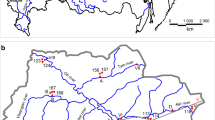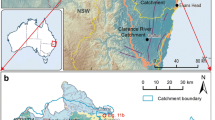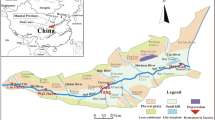Abstract
Widespread climate change can impact on groundwater conditions. We evaluated the groundwater data for 1996–2008 obtained from the National Groundwater Monitoring Stations (NGMS), in the context of the global warming effect. Indications of air temperature and sea level rises were evident in the period. The groundwater levels were generally decreasing and most of this decrease was attributed to increased pumping nationwide, but no indication for any effect of sea level rise on groundwater level in coastal aquifers was found. The electrical conductivity (EC) values of groundwaters were very high in metropolitan and industrial areas, which were indicative of anthropogenic groundwater contamination and progressive groundwater quality deterioration. A systematic EC rise in coastal groundwaters, as a possible result of the sea level rise, was not observed. The groundwater temperature variation was the most striking. The majority of the monitored shallow and deep groundwaters exhibited increasing trends at mean rates of 0.04–0.09 °C/yr. The widespread and prevailing increase in groundwater temperature nationwide, with increasing air temperature, is strongly indicative of the effect of global warming. The increasing trend became more distinctive every year. However, these significant conclusions require further groundwater monitoring and re-evaluation.
Similar content being viewed by others
References
Adger, W.N., Arnell, N.W., and Tompkins, E.L., 2005, Successful adaptation to climate change across scales. Global Environmental Change, 15, 77–86.
Baek, W. and Lee, J.Y., 2011, Source apportionment of trichloroethylene in groundwater of an industrial complex in Korea: a 15-year dispute and perspective. Water and Environment Journal. (in press)
CCIC (Climate Change Information Center), 2010, www.climate.go.kr. Access on July 5, 2010.
Chae, G.T., Yun, S.T., Choi, B.Y., Yu, S.Y., Jo, H.Y., Mayer, B., Kim, Y.J., and Lee, J.Y., 2008, Hydrochemistry of urban groundwater, Seoul, Korea: the impact of subway tunnels on groundwater quality. Journal of Contaminant Hydrology, 101, 42–52.
Cho, I.H., Choi, K., Kang, H., and Zoh, K.D., 2008, Risk assessment before and after solar photocatalytic degradation of BTEX contaminated groundwater at a gas station site in Korea. Environmental Progress, 27, 447–459.
Cho, K.W. and Kim, G.J., 2009, Sea level rise and vulnerability of Korean coast. Environment Forum, 13, 1–8. (in Korean)
Cho, K.W., Kim, J.H., Jung, H.C., Mimura, N., and Nicholls, R.J., 2002, Sea Level Rise and its Possible Impact near the Korea due to Global Warming II. KEI, Seoul, 220 p. (in Korean)
Choi, H.M. and Lee, J.Y., 2009, Parametric and non-parametric trend analyses for water levels of groundwater monitoring wells in Jeju Island. Journal of Soil and Groundwater Environment, 14, 41–50. (in Korean)
Chung, U., Choi, J., and Yun, J.I., 2004a, Urbanization effect on the observed change in mean monthly temperatures between 1951–1980 and 1971–2000 in Korea. Climate Change, 66, 127–136.
Chung, Y.S., Yoon, M.B., and Kim, H.S., 200b, On climate variations and changes observed in south Korea. Climate Change, 66, 151–161.
Danielopol, D.L., Griebler, C., Gunatilaka, A., and Notenboom, J., 2003, Present state and future prospects for groundwater ecosystems. Environmental Conservation, 30, 104–130.
Eckhardt, K. and Ulbrich, U., 2003, Potential impacts of climate change on groundwater recharge and streamflow in a central European low mountain range. Journal of Hydrology, 284, 244–252.
Ho, C.H., Lee, J.Y., Ahn, M.H., and Lee, H.S., 2003, A sudden change in summer rainfall characteristics in Korea during the late 1970s. International Journal of Climatology, 23, 117–128.
IPCC (International Panel on Climate Change), 2007, Climate Change 2007: Synthesis Report. IPCC, Geneva, Switzerland, 104 p.
Karl, T.R. and Trenberth, K.E., 2003, Modern global climate change. Science, 302, 1719–1723.
Kendall, M.G., 1975, Rank Correlation Methods. Charles Griffin, London, 202 p.
Kim, K.H., Shin, J., Koh, E.H., Koh, G.W., and Lee, K.K., 2009, Sea level rise around Jeju Island due to global warming and movement of groundwater/seawater interface in the eastern part of Jeju Island. Journal of Soil and Groundwater Environment, 14, 68–79. (in Korean)
Lee, J.Y., 2010, Comment on “Groundwater monitoring in Denmark: characteristics, perspectives and comparison with other countries”: report published in Hydrogeology Journal (2009) 17: 827–842, by Lisbeth Flindt Jorgensen, Jens Stockmarr. Hydrogeology Journal, 18, 803–804.
Lee, J.Y., 2011, Environmental issues of groundwater in Korea: implications for sustainable use. Environmental Conservation. (in press)
Lee, J.Y. and Song, S.H., 2007, Evaluation of groundwater quality in coastal areas: implications for sustainable agriculture, Environmental Geology, 52, 1231–1242.
Lee, J.Y. and Song, S.H., 2009, Discussion on “sea level rise around Jeju Island due to global warming and movement of groundwater/seawater interface in the eastern part of Jeju Island”. Journal of Soil and Groundwater Environment, 14, 1–4. (in Korean)
Lee, J.Y., Yi, M.J., Lee, J.M., Ahn, K.H., Won, J.H., Moon, S.H., and Cho, M., 2006, Parametric and non-parametric trend analysis of groundwater data obtained from national groundwater monitoring stations. Journal of KoSSGE, 11, 56–67. (in Korean)
Lee, J.Y., Yi, M.J., Yoo, Y.K., Ahn, K.H., Kim, G.B., and Won, J.H., 2007, A review of national groundwater monitoring network (NGMN) in Korea. Hydrological Processes, 21, 907–919.
Lee, K.S. and Chung, E.S., 2007, Hydrological effects of climate change, groundwater withdrawal, and land use in a small Korean watershed. Hydrological Processes, 21, 3046–3056.
Mann, H.B., 1945, Nonparametric tests against trend. Econometrica, 13, 245–259.
Meehl, G.A., Washington, W.M., Collins, W.D., Arblaster, J.M., Hu, A., Buja, L.E., Strand, W.G., and Teng, H., 2005, How much more global warming and sea level rise? Science, 307, 1769–1772.
Melillo, J.M., McGuire, A.D., Kicklighter, D.W., Moore III.B., Vorosmarty, C.J., and Schloss, A.L., 1993, Global climate change and terrestrial net primary production. Nature, 363, 234–240.
NewHankuk, 2009, Burning Gangwon Province: the most severe in 35 years. NewHankuk.com, Feb. 13, 2009. (in Korean)
Park, S.C., Yun, S.T., Chae, G.T., Yoo, I.S., Shin, K.S., Heo, C.H., and Lee, S.K., 2005, Regional hydrochemical study on salinization of coastal aquifers, western coastal area of South Korea. Journal of Hydrology, 313, 182–194.
Sen, P.K., 1968, Estimates of the regression coefficient based on Kendall’s test. Journal of American Statistics Association, 63, 1379–1389.
Shah, T., Molden, D., Sakthivadivel, R., and Seckler, D., 2000, The Global Groundwater Situation: Overview of Opportunities and Challenges. Colombo, Sri Lanka, International Water Management Institute, 30 p.
Taniguchi, M. and Uemura, T., 2005, Effects of urbanization and groundwater flow in the subsurface temperature in Osaka, Japan. Physics of the Earth and Planetary Interiors, 152, 305–313.
Taniguchi, M., Uemura, T., and Jago-on, K., 2007, Combined effects of urbanization and global warming on subsurface temperature in four Asian cities. Vadose Zone Journal, 6, 591–596.
Tillman, F.D. and Leake, S.A., 2010, Trends in groundwater levels in wells in the active management areas of Arizona, USA. Hydrogeology Journal. (in press)
Vorosmarty, C.J., Green, P., Salisbury, J., and Lammers, R.B., 2000, Global water resources: vulnerability from climate change and population growth. Science, 289, 284–288.
Wentz, F.J., Ricciardulli, L., Hilburn, K., and Mears, C., 2007, How much more rain will global warming bring? Science, 317, 233–235.
Youn, Y.H., 2008, The climate variabilities of air temperature around the Korean Peninsular. Advances in Atmospheric Sciences, 22, 575–584.
Author information
Authors and Affiliations
Corresponding author
Rights and permissions
About this article
Cite this article
Park, YC., Jo, YJ. & Lee, JY. Trends of groundwater data from the Korean National Groundwater Monitoring Stations: indication of any change?. Geosci J 15, 105–114 (2011). https://doi.org/10.1007/s12303-011-0006-z
Received:
Accepted:
Published:
Issue Date:
DOI: https://doi.org/10.1007/s12303-011-0006-z




